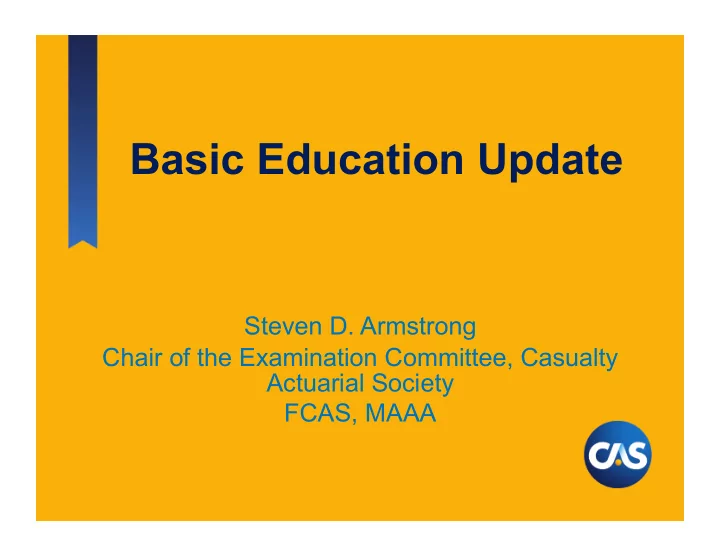

Basic Education Update Steven D. Armstrong Chair of the Examination Committee, Casualty Actuarial Society FCAS, MAAA
Strategy: Basic Education � Increase the scope and breadth of statistics on the syllabus and decrease the amount of less relevant material. � Increase the use of technology in the delivery of educational material and in the validation of candidates' mastery of the syllabus. � Improve communications and relationships with candidates and academics. 2
Basic Education: Statistics � No major changes in content on preliminary exams (likely some consolidation and repackaging). � New Statistics exam - designed to cover material such as: • Markov Chains, MCMC, GLMs and extended linear models, Decision Trees, Spatial Statistics, Visualization & Fit, and familiarity with other modeling techniques (neural nets, ensemble methods, etc). � New Statistics module - demonstrate how statistical techniques are applied to real actuarial case studies in ratemaking, reserving, and enterprise risk management. � Tentatively calling these a new series of Statistical Exams (S1, S2, and S3) 3
Basic Education: Technology � Looking to change the way exams are taken and graded. � New Technology Task Force aimed at finding solutions to allow candidates to take exams in more real-life situations (Word for responding to an essay questions, Excel for crunching through a reserving triangle, and maybe some R to potentially develop predictions on large databases for Stats exams). � The new technology may also change how we grade and may evolve to using more multiple choice questions on upper level exams. 4
Basic Education: Communications � Increased communication with candidates through articles in Future Fellows. � Increased communication with academics through the University Liaisons, Student Central, and Academic Central. � Greater use of social media, blogs, online communities, etc. to communicate. 5
Expectations � Aiming for new Statistics exams to be ready starting in 2015 (S1), 2016 (S2) and 2017 (S3). � Continuously improving communications of Admissions-related developments to students, candidates, academics, employers, and members. � Keeping the Syllabus “net neutral” in terms of content, number of hours, etc. 6
Recommend
More recommend